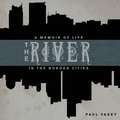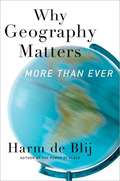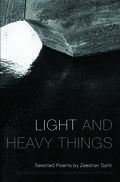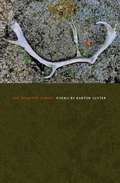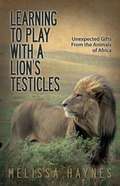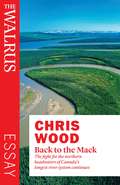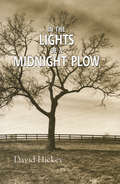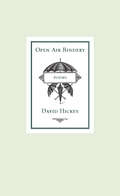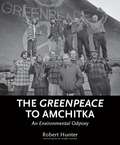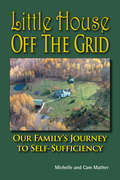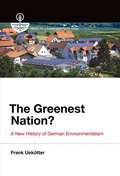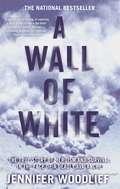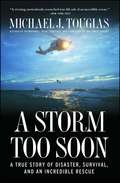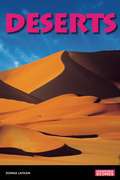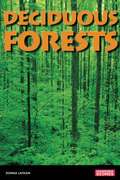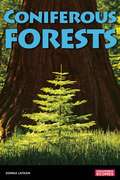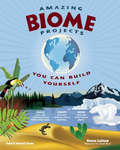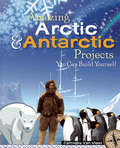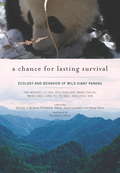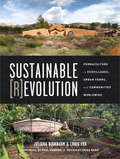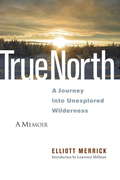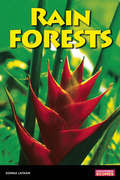- Table View
- List View
The River
by Paul Vasey"Ask anyone what they love most about Winzer, and they seem always to tell you it's the people, the family and friends webbed around each of us. True. But for me the town is also, and perhaps mainly, the larger-than-life characters who ghost around in my imagination and my memory: rumrunners and prize fighters and elegant old ladies and one-eyed thugs and earnest well-meaning politicians and hucksters and hookers and crusty old editors. Many of them I remember meeting. Some of them I actually met." -from The RiverThe River is Paul Vasey's tribute to a place he discovered by accident and loved over a lifetime. Chatty, anecdotal, personal and passionate, by one of Windsor's most celebrated reporters and radio hosts, this meandering memoir winds its way around a river town whose sights and characters may never be fully charted: a Windsor that fired a reporter's imagination, stole his heart, and eventually became the place he calls home.
Why Geography Matters: More Than Ever
by Harm De BlijFor anyone trying to understand our complex and dynamic world, this book offers not only a unique trove of concepts and ideas, but links them clearly and directly to world events.
Light and Heavy Things
by Christopher Kennedy Faisal Siddiqui Zeeshan Sahil Mi DitmarLight and Heavy Things provides readers in this country an opportunity to discover the work of the late Pakistani poet, Zeeshan Sahil. Although readers of Urdu poetry mourned his passing in 2008, Sahil is a relatively unknown poet in the United States. Sahil's work conveys his post-modern sensibility with plain language, presenting political realities of Pakistan in personal terms.
The Reindeer Camps
by Barton SutterA winner of the Minnesota Book Award in fiction, poetry, and non-fiction, Barton Sutter's latest collection details life on the Canadian border, presents portraits of northern plants and animals, rejoices in marriage, and traces the ancient ways of Siberian reindeer herders. The late Bill Holm called it "unlike anything Sutter (or anyone else) has done before." Sutter's poetry reminds us that other cultures have survived for millennia by living closer to the ground.Born in 1949, Barton Sutter was raised in Minnesota and Iowa. He retired from the University of Wisconsin-Superior in 2011 and now lives in Duluth, Minnesota.
The Poetic Species
by Edward O. Wilson Robert Hass Lee Briccetti"Wilson brilliantly analyzes the force, at once creative and destructive, of our biological inheritance and daringly advances a grand theory of the origins of human culture." -STEPHEN GREENBLATT, author of The Swerve on Edward O. Wilson's The Social Conquest of Earth"Hass [is] a philosophically attentive observer, deep thinker, and writer who dazzles and rousts." -Booklist on Robert Hass' What Light Can DoIn this shimmering conversation (the outgrowth of an event co-sponsored by the American Museum of Natural History and Poets House), Edward O. Wilson, renowned scientist and proponent of "consilience" or the unity of knowledge, finds an ardent interlocutor in Robert Hass, whose credo as U.S. poet laureate was "imagination makes communities." As they explore the many ways that poetry and science enhance each other, they travel from anthills to ancient Egypt and to the heights and depths of human potential. A testament to how science and the arts can join forces to educate and inspire, it ends in a passionate plea for conservation of all the planet's species.Edward O. Wilson, a biologist, naturalist, and bestselling author, has received more than 100 awards from around the world, including the Pulitzer Prize. A professor emeritus at Harvard University, he lives in Lexington, Massachusetts.Robert Hass' poetry is rooted in the landscapes of his native northern California. He has been awarded the MacArthur "Genius" Fellowship, the National Book Critics Circle Award (twice), the Pulitzer Prize, and the National Book Award. He is a professor of English at University of California-Berkeley.
Learning to Play With a Lion's Testicles
by Melissa HaynesThe cheeky title of Melissa Haynes's story of adventure in Africa, Learning to Play with a Lion's Testicles, earned the book some big publicity on NBC-TV/Late Night with Jimmy Fallon on September 4,2013 where it topped the show's list of "Titles Not to Read" for September 2013. Melissa's book was also a big smash on the March 11, 2014 Ellen Show, where Ellen and guest Ricky Gervais highlighted the book throughout the entire hour. Playing with a lion's testicles: An African saying that means to take foolhardy chances.Melissa, an exhausted executive from the city seeks meaning and purpose from her work, and volunteers for a Big Five conservation project in South Africa. Her boss, an over-zealous ranger, nicknamed the Drill Sergeant, has no patience for city folk, especially if they're women, and tries to send her packing on day one. But Melissa stands her ground with grit and determination, however shaky it may be.Conflict soon sets the pace with a cast filled with predatory cats, violent elephants, and an on-going battle of wits with the Drill Sergeant. Even Mother Nature pounds the reserve with the worst storm in a century. But the most enduring and profound conflict is the internal battle going on within Melissa, as she tries to come to terms with the guilt surrounding her mother's death. When death grips the game reserve, it is the very animals Melissa has come to save that end up saving her.For the reader who has ever dreamed of going to Africa or knows the pain of loss and guilt, LEARNING TO PLAY WITH A LION'S TESTICLES will fill your soul.
Back to the Mack
by Chris WoodBack to the Mack is an ebook by award-winning journalist and author Chris Wood. It contains his seminal story about the Mackenzie River, "The Last Great Water Fight," first featured in the October 2010 issue of The Walrus. The ebook also includes "Back to the Mack," in which Wood returns to the Mackenzie four years after his original story and chronicles the development of natural resources affecting both the river and the extensive ecosystems and communities it supports. These two articles also serve as companion content to the brand-new original documentary http://thewalrus.ca/cold-amazon, produced by the Walter and Duncan Gordon Foundation. Cold Amazon will be available to view for free as of March 17 at http://thewalrus.ca/cold-amazon.
In the Lights of a Midnight Plow
by David HickeyIn the Lights of a Midnight Plow, glitters and startles. The writing is deftly musical, where every detail and image has been carefully weighed, honed with a knife's edge and poet's ear. There is language, the sparkle and sheen of it, the rhythm, all of which tells us that a new and important voice is at work here.
Open Air Bindery
by David HickeyDavid Hickey's second collection builds upon the myriad strengths of his first. In a specimen book of songs, stories, and covenants, Hickey's subjects range from art and astronomy to snowflakes and suburbia. These poems "take their time / Covering the roadside trees in forms of their careful willing . . . gesturing down to earth, unveiling new shapes / for all that they find."David Hickey is a past recipient of the Milton Acorn Prize, the Ralph Gustafson Prize for Poetry, and was shortlisted for the Gerald Lampert Award for best first book of poetry in Canada. His work has appeared in magazines and journals across Canada and the United States.
The Greenpeace to Amchitka
by Robert Keziere Robert HunterGreenpeace is known around the world for its activism and education surrounding environmental and biodiversity issues. With a presence in more than 40 countries across Europe, the Americas, Asia and the Pacific, Greenpeace is undoubtedly a dominant force in the realm of environmental activism.This is the story of how Greenpeace came to be.In September 1971, a small group of activists boarded a small fishing boat in Vancouver, Canada, and headed north towards Amchitka, a tiny island west of Alaska in the Aleutian Islands, where the US government was conducting underground nuclear tests.At that time, protests against nuclear testing were not common, yet the US tests raised genuine concerns: Amchitka is not only the last refuge for endangered wildlife, but is also located in a geologically unstable region, one of the most earthquake-prone areas in the world. The threat of a nuclear-triggered earthquake or tsunami was real.Among the people sardined in the fishing boat were Robert Hunter and Robert Keziere.The boat, named the Greenpeace by the small group of men aboard, raced against time as it crashed through the Gulf of Alaska, braving the oncoming winter storms. Three weeks was all they had to reach Amchitka in an attempt to halt the nuclear test. Ultimately, the voyage--beset by bad weather, interpersonal tensions and conflicts with US officials--was doomed. And yet the legacy of that journey lives on.In this visceral memoir, based on a manuscript originally written over 30 years ago, Robert Hunter vividly depicts the peculiar odyssey that led to the formation of the most powerful environmental organization in the world.Features 40 black and white photographs taken during the voyage by Robert Keziere.
Little House Off the Grid
by Cam Mather Michelle MatherLike so many other city-dwellers, Cam and Michelle Mather longed for a simpler, quieter life in the country. When they found a century-old farmhouse on 150 acres of land that was in their price range, they jumped at the chance to make their move. The fact that the home was "off-grid" with no power or telephone lines connecting it to the outside world seemed like a bonus!Twelve years later their life in the country is not quite as simple as they had envisioned, but it is peaceful. There were more challenges than they could have anticipated, as well as more rewards.Along the way they installed more solar panels, erected a wind turbine, and upgraded and replaced all of the major components of their off-grid electrical system. They installed a solar-thermal hot water system; figured out how to have a phone, internet, and satellite TV; and kept their home heated with wood cut from their own property. They also carved out a garden and began growing much of their own food.They acquired new skills and knowledge, but, most importantly, they learned to appreciate the value of good neighbors, good books, and good manure.Cam Mather is a writer, publisher, and video producer who knows how to equalize batteries and pinch suckers off of tomato plants.Michelle Mather looks after the editing, the website, and the dwindling bank account and keeps Cam calm during times of crisis.
The Greenest Nation?
by Frank UekötterGermany enjoys an enviably green reputation. Environmentalists in other countries applaud its strict environmental laws, its world-class green technology firms, its phase-out of nuclear power, and its influential Green Party. Germans are proud of these achievements, and environmentalism has become part of the German national identity. In The Greenest Nation? Frank Uekötter offers an overview of the evolution of German environmentalism since the late nineteenth century. He discusses, among other things, early efforts at nature protection and urban sanitation, the Nazi experience, and civic mobilization in the postwar years. He shows that much of Germany's green reputation rests on accomplishments of the 1980s, and emphasizes the mutually supportive roles of environmental nongovernmental organizations, corporations, and the state. Uekötter looks at environmentalism in terms of civic activism, government policy, and culture and life, eschewing the usual focus on politics, prophets, and NGOs. He also views German environmentalism in an international context, tracing transnational networks of environmental issues and actions and discussing German achievements in relation to global trends. Bringing his discussion up to the present, he shows the influence of the past on today's environmental decisions. As environmentalism is wrestling with the challenges of the twenty-first century, Germany could provide a laboratory for the rest of the world.
A Wall of White: The True Story of Heroism and Survival in the Face of a Deadly Avalanche
by Jennifer WoodliefOne of the most amazing survival stories ever told -- journalist Jennifer Woodlief's gripping account of the deadliest ski-area avalanche in North American history and the woman who survived in the face of incalculable odds.
The Allocation of Regulatory Competence in the EU Emissions Trading Scheme
by Josephine Van ZebenThe European Union's Emissions Trading System (EU ETS) is the world's largest carbon trading market. This book offers a new perspective on the EU ETS as a multi-level governance regime, in which the regulatory process is composed of three distinct 'competences' - norm setting, implementation, and enforcement. Are these competences best combined in a single regulator at one level of government or would they be better allocated among a variety of regulators at different levels of government? The combined legal, economic, and political analysis in this book reveals that the actual allocation of competences within the EU ETS diverges from a hypothetical ideal allocation in important ways, and provides a political economy explanation for the existing allocation of norm setting, implementation and enforcement competences among various levels of European government.
Writing Metamorphosis in the English Renaissance
by Susan WisemanTaking Ovid's Metamorphoses as its starting point, this book analyses fantastic creatures including werewolves, bear-children and dragons in English literature from the Reformation to the late seventeenth century. Susan Wiseman tracks the idea of transformation through classical, literary, sacred, physiological, folkloric and ethnographic texts. Under modern disciplinary protocols these areas of writing are kept apart, but this study shows that in the Renaissance they were woven together by shared resources, frames of knowledge and readers. Drawing on a rich collection of critical and historical studies and key philosophical texts including Descartes' Meditations, Wiseman outlines the importance of metamorphosis as a significant literary mode. Her examples range from canonical literature, including Shakespeare's A Midsummer Night's Dream and The Tempest, to Thomas Browne on dragons, together with popular material, arguing that the seventeenth century is marked by concentration on the potential of the human, and the world, to change or be changed.
A Storm Too Soon
by Michael J. TougiasFROM MASTERFUL STORYTELLER MICHAEL J. TOUGIAS COMES A NEW, HEART-STOPPING TRUE-LIFE TALE OF MARITIME DISASTER, SURVIVAL, AND DARING RESCUE, HIS MOST THRILLING AND AMAZING STORY YET. Seventy-foot waves batter a torn life raft 250 miles out to sea in one of the world's most dangerous places, the Gulf Stream. Hanging on to the raft are three men, a Canadian, a Brit, and their captain, JP de Lutz, a dual citizen of America and France. Their capsized forty-seven-foot sailboat has filled with water and disappeared below the tempestuous sea. The giant waves repeatedly toss the men out of their tiny vessel, and JP, with nine broken ribs, is hypothermic and on the verge of death. The captain, however, is a remarkably tough character, having survived a brutal boyhood, and now he must rely on the same inner strength to outlast the storm. Trying to reach these survivors before it's too late are four brave Coast Guardsmen battling hurricane- force winds in their Jayhawk helicopter. They know the waves will be extreme, but when they arrive they are astounded to find that the monstrous seas have waves reaching eighty feet. Lowering the wind-whipped helicopter to drop a rescue swimmer into such chaos will be extremely dangerous. The pilots wonder if they have a realistic chance of saving the sailors clinging to the broken life raft, and if they will be able to even retrieve their own rescue swimmer from the towering seas. Once they commit to the rescue, they find themselves in almost as much trouble as the survivors, facing one life-and-death moment after the next. Also caught in the storm are three other boats, each one in a Mayday situation. Of the ten people on these boats, only six will ever see land again. Spellbinding, harrowing, and meticulously researched, A Storm Too Soon is a vivid account about the powerful collision between the forces of nature and the human will to survive. Author Michael J. Tougias, known for his fast-paced writing style and character-driven stories, tells this true saga in the present tense to give the reader a thrilling, edge-of-your-seat immediacy. A Storm Too Soon is Tougias at his masterful best and a heart-pounding narrative of survival, the power of the human spirit, and one of the most incredible rescues ever attempted.
Deserts
by Donna LathamInvestigating the planet's biomes and examining the modern threats to each ecosystem, this interactive series challenges young readers to look at how their own actions influence the planet's health. With compare-and-contrast facts and vocabulary-building sidebars, each engaging guide reveals how environmental threats-both human and natural-affect plants and animals. Examining this growing biome, this guide shows that the desert is more than just a giant sandbox. Discussing desertification and how environmental change-such as ranching, overdevelopment, and cactus collection-in this area can threaten life outside the desert, this resource instructs students on the need to treat the desert with care.
Deciduous Forests
by Donna LathamInvestigating the planet's biomes and examining the modern threats to each ecosystem, this interactive series challenges young readers to look at how their own actions influence the planet's health. With compare-and-contrast facts and vocabulary-building sidebars, each engaging guide reveals how environmental threats-both human and natural-affect plants and animals.Showcasing the diverse woodland of deciduous forests, this resource reveals how many of its threats come from humans. Covering topics such as deforestation, acid rain, disease, and invasive species, this engaging guide shows how, in the complicated web of life in the forest, even natural threats can be made worse by human activity.
Coniferous Forests
by Donna LathamInvestigating a variety of biomes and today's natural and human threats to their preservation, this interactive series challenges young readers to look at how their own actions influence the planet's health. Four distinct environments are explored in detail, showcasing the assortment of plants and animals that inhabit these outdoor communities as well as how they have adapted to their surroundings. Offering fascinating facts on each ecosystem along with vocabulary-building sidebars, these guides show budding scientists how they can contribute towards ongoing conservation efforts. The diverse woodland of coniferous forests is revealed in this detailed resource, covering topics such as the dangers of deforestation, over hunting, and forest fires, illustrating the rapid decline of this ecosystem's biodiversity.
AMAZING BIOME PROJECTS
by Donna Latham Farah RizviAmazing Biome Projects You Can Build Yourself takes kids ages 9 and up on a circumnavigation of the globe to learn about Earth's terrestrial and aquatic biomes. Kid's will wander through forests, sizzle in deserts, shiver in the tundra, plunge beneath the seas to explore coral reefs, and slog through marshy waters. Along the way, kids will encounter flora and fauna adapted for survival in each unique climate zone. They'll learn about gnarly krumholz trees, bioluminescent sea creatures, camouflage, carnivorous plants, and blubbery marine critters. In each biome, people who use science in their jobs are highlighted, whether at the site of a disastrous oil spill or an oh-so-cool mastodon dig.
Amazing Arctic and Antarctic Projects
by Steven Weinberg Carmella Van VleetAmazing Arctic & Antarctic Projects You Can Build Yourself explores the Earth's polar regions with 25 interactive projects, activities, and experiments. Kids ages 9 and up will discover that the coldest places on Earth hold fascinating scientific wonders and mysteries. Historical facts and anecdotes, biographies, and fascinating trivia support the fun projects to teach young readers about the harsh polar climate, immense Arctic tundra, magical Northern Lights, vast glaciers, ancient frozen lakes, remarkable animals and plants, brave explorers, innovative people who live and work at the top and bottom of the world, and the vital importance of conservation. With Amazing Arctic & Antarctic Projects You Can Build Yourself kids will gain an appreciation for the exciting and extraordinary polar environments.
A Chance for Lasting Survival
by David Garshelis Wang Dajun Richard B. Harris William J. Mcshea Pan WenshiFrom 1984 through 1995 a small band of ecologists led by Pan Wenshi from Peking University conducted a study of wild giant pandas in the Qinling Mountains of Shaanxi Province. This project was the first Chinese-led conservation project in China and was conducted during a significant transition period in Chinese history, as the country opened its society and science to the world. The project focused on behavioral observation of wild giant pandas, but evolved to include physiology, nutrition, ecology, land-use policy, and population biology as the staff became more aware that the issues with captive pandas (assisted reproduction, unusual diet, and genetic inbreeding) were not the most critical to survival of wild populations. It is evident in this work that, as the scientists gained knowledge, they came to see giant panda conservation as wrapped in landscape ecology and human/wildlife interactions. The group was seminal in the Chinese government's enactment of a logging ban to their study area by advocating for pandas at the national level. The project was summarized in a 2001 volume, but its publication in Mandarin limited its influence on the greater conservation community. This English version of the original work translates, condenses, and refines the original volume, with added contextual chapters on the importance of this volume and how our understanding of giant panda conservation is shaped by this pioneering field work.
Sustainable Revolution
by Paul Hawken Louis Fox Juliana Birnbaum Erika RandUrban gardeners. Native seed-saving collectives. Ecovillage developments. What is the connection between these seemingly disparate groups? The ecological design system of permaculture is the common thread that weaves them into a powerful, potentially revolutionary--or reevolutionary--movement. Permaculture is a philosophy based on common ethics of sustainable cultures throughout history that have designed settlements according to nature's patterns and lived within its bounds. As a movement that has been building momentum for the past 40 years, it now is taking form as a growing network of sites developed with the intention of regenerating local ecologies and economies. Permaculture strategies can be used by individuals, groups, or nations to address basic human needs such as food, water, energy, and housing. As a species, humans are being called forth to evolve, using our collective intelligence to meet the challenges of the future. Yet if we are to survive our collective planetary crisis, we need to revisit history, integrating successful systems from sustainable cultures. To boldly confront our position on the brink of the earth's carrying capacity and make changes that incorporate the wisdom of the past is truly revolutionary. Sustainable Revolution features the work of a worldwide network of visionaries, including journalists, activists, indigenous leaders and permaculturists such as David Holmgren, Vandana Shiva, Charles Eisenstein, Starhawk, Erik Assadourian, Victoria Tauli-Corpuz, Albert Bates, and Geoff Lawton. This beautifully photographed collection of profiles, interviews, and essays features 60 innovative community-based projects in diverse climates across the planet. Edited by anthropologist Juliana Birnbaum Fox and award-winning activist filmmaker Louis Fox, it can be read as an informal ethnography of an international culture that is modeling solutions on the cutting edge of social and environmental change. The research presented in the book frames the permaculture movement as a significant ally to marginalized groups, such as the urban poor and native communities resisting the pressures of globalization. Sustainable Revolution uplifts and inspires with its amazing array of dynamic activists and thriving, vibrant communities.From the Trade Paperback edition.
True North
by Lawrence Millman Elliott MerrickWhile many people dream of abandoning civilization and heading into the wilderness, few manage to actually do it. One exception was twenty-four-year-old Elliott Merrick, who in 1929 left his advertising job in New Jersey and moved to Labrador, one of Canada's most remote regions. First published by Scribner's in 1933, True North tells the captivating story of one of the high points of Merrick's years there: a hunting trip he and his wife, Kay, made with trapper John Michelin in 1930. Covering 300 miles over a harsh winter, they experienced an unexplored realm of nature at its most intense and faced numerous challenges. Merrick accidentally shot himself in the thigh and almost cut off his toe. Freezing cold and hunger were constant. Nonetheless, the group found beauty and even magic in the stark landscape. The couple and the trappers bonded with each other and their environment through such surprisingly daunting tasks as fabricating sunglasses to avoid snow blindness and learning to wash underwear without it freezing. Merrick's intimate style, rich with narrative detail, brings readers into a dramatic story of survival and shares the lesson the Merricks learned: that the greatest satisfaction in life can come from the simplest things.From the Trade Paperback edition.
Rain Forests
by Donna LathamInvestigating a variety of biomes and today's natural and human threats to their preservation, this interactive series challenges young readers to look at how their own actions influence the planet's health. Four distinct environments are explored in detail, showcasing the assortment of plants and animals that inhabit these outdoor communities as well as how they have adapted to their surroundings. Offering fascinating facts on each ecosystem along with vocabulary-building sidebars, these guides show budding scientists how they can contribute towards ongoing conservation efforts. Showcasing one of the environment's most valuable biomes, this overview centers on the planet's rain forests, reviewing the greenhouse gases and the accelerating extinction of species that jeopardize this vital ecosystem's future.
